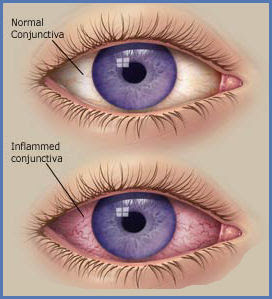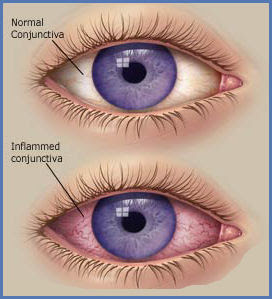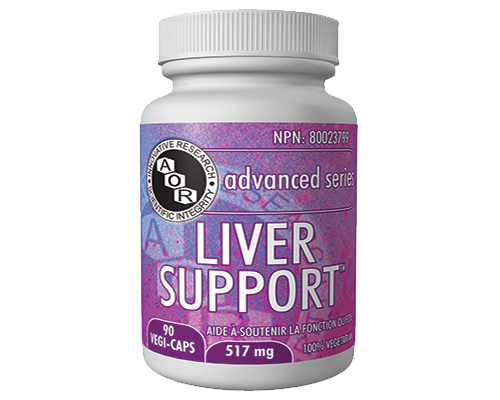Pink eye, or Conjunctivitis, is a very common eye ailment that has infected many of us. It is caused by an infection or inflammation of the conjunctiva (the outermost layer of the eyeball). Pink eye can be caused by bacterial infections, viruses, or allergies. If pink eye develops, the sclera (white part of the eye) may become red or pink in color. There may be discharge, which can further irritate the eyes. Often the condition appears in a single eye and then spreads to the other. There are several types of pink eye, and most are contagious. Depending on which type of pink eye you have, symptoms may happen up to between seven and fourteen days.

Pink eyes can be contracted numerous ways. Viral and bacterial conjunctivitis are the most common ways for pink eye to spread from person to person. You can contract it simply by touching your eye after touching an infected surface or object such as a doorknob or shopping cart, or by using infected mascara or eye drops. Other times, pink eye develops as a symptom of a disease. For example, if you contract Chlamydia you may experience a pink or red eye as a symptom. If you are subject to seasonal allergies, you may experience pink eye during times of the year when pollen and other allergens fill the air.
Pink Eye Symptoms
Some of the symptoms of pink eye are unique to certain types of pink eye. The most noticeable sign is the pink to reddish color of the eyes, which is due to inflammation of the conjunctiva. Irritation and itchiness are two other common symptoms of conjunctivitis. Tearing is another prevalent symptom, as the eyes naturally produce more tears in order to relieve the discomfort. Some types of pink eye cause discharge; this may be frequent in both viral and bacterial conjunctivitis. This discharge may be yellow or green, and it can cause the eyelids to stick together or it can flow out of the eyes. Following are the symptoms that should be looked out for-
Viral Conjunctivitis Symptoms
- Watery eyes along with discharge
- Discomfort
- Itchiness
- The infection usually affects one eye, but it can affect both
- Bacterial Conjunctivitis Symptoms
- Watery eyes followed with yellow or green discharge
- Irritation and redness
- The infection usually starts with one eye and spreads to the other
- Allergic Conjunctivitis Symptoms
- Heavy tearing
- Itchiness affecting both eyes is especially likely
- Swollen or puffy eyes and eyelids
- Eye Drop Conjunctivitis Symptoms
- Redness in eyes
- Irritation
- Herpes Simplex Conjunctivitis Symptoms
- Severe burning sensations
- Severe pain
- Blisters may develop on conjunctiva or eyelids
- Giant Papillary Conjunctivitis Symptoms
- Inability to wear or tolerate contact lenses
- Large amount of discharge
- Excessive tearing
- Red bumps on underside of eyelids
- Neonatal Conjunctivitis Symptoms
- Redness of eyes
- Swollen or puffy eyelids
- Discharge
- One or both eyes may be affected
- Vernal Conjunctivitis Symptoms





